|
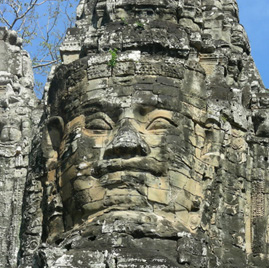
 Karen's Perspective on Traveling Alone Karen's Perspective on Traveling Alone






















|
I turned over in my tent at 4am to the sound of a low fairly long growl or howl or what was it? I was camped at Sprague Campground along the shore of Lake McDonald in Glacier National Park. The haunting sound seemed to come from quite a ways away but was nothing I had heard before - not any kind of cat, not a coyote - in my groggy state I settled on "wolf" and easily went back to sleep, knowing I would confirm my hunch the following day. I figured if anyone would know, it would have to be Doug, an 89 year old ranger who just happened to be the guide on the Lake McDonald boat tour. He confirmed that there is a pack of wolves that lives on the north side of the lake and when the wind blows south it sounds an awful lot like this YouTube video. He demonstrated the sound and it was the same plaintive howl I had heard from my tent.
I arrived into Glacier the way I think it's best to arrive in any remote and revered location - by foot, horse or train. Driving a personal car just seems somehow wrong, especially to a place most well-known now for how quickly its glaciers (like my gums) are receding. Park officials have installed a large sign at the trailhead and Visitor Center at Logan Pass declaring that the park might include only snowfields and no glaciers as early as 2020. I had flown to Seattle (big carbon footprint) and taken the 30 minute and $3 light rail to the newly renovated King Street Station where I boarded Amtrak's Empire Builder. I enjoyed the spartan but clean and comfortable "roomette" where I slept soundly. But first I took in the sights of Puget Sound and the Olympic mountains before we passed into the Cascades with undisturbed swaths of Douglas fir, cedar and spruce.
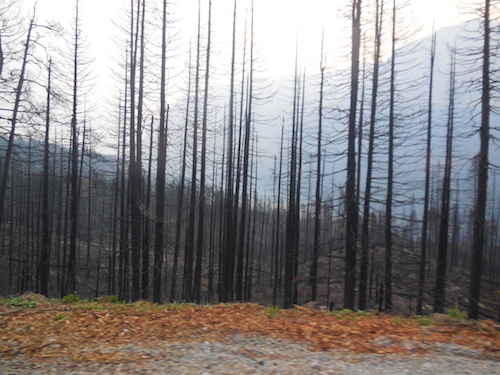 Even though I had frequently been on the park's website to monitor the wildfires, I was appalled to lift my blinds in the morning and see the sickening haze around gorgeous Whitefish Lake, as the train hugged its curve to arrive at the Whitefish, MT station. A fierce orange ball of sun rose to announce another day of burning forest fires and smoke. I've never been a huge train buff like some of the folks on board I met who were making their regular crossing from Seattle to Chicago, but I was a bit reluctant to be already getting off the train. The night had passed too quickly and I wanted an hour or two more of the "clicketty clack down the straight line track" so I could just zone out and drop into the perfection of the solitude - me, the train and the landscape out my window. Whitefish was the last stop before arriving in West Glacier, MT, the only national park where Amtrak goes. Even though the visibility was limited, I felt an immediate surge of joy as I debarked (or "unlighted" as my Kenyan friends say) with my backpack and rolling bag at the picturesque crossroads.
Even though I had frequently been on the park's website to monitor the wildfires, I was appalled to lift my blinds in the morning and see the sickening haze around gorgeous Whitefish Lake, as the train hugged its curve to arrive at the Whitefish, MT station. A fierce orange ball of sun rose to announce another day of burning forest fires and smoke. I've never been a huge train buff like some of the folks on board I met who were making their regular crossing from Seattle to Chicago, but I was a bit reluctant to be already getting off the train. The night had passed too quickly and I wanted an hour or two more of the "clicketty clack down the straight line track" so I could just zone out and drop into the perfection of the solitude - me, the train and the landscape out my window. Whitefish was the last stop before arriving in West Glacier, MT, the only national park where Amtrak goes. Even though the visibility was limited, I felt an immediate surge of joy as I debarked (or "unlighted" as my Kenyan friends say) with my backpack and rolling bag at the picturesque crossroads.
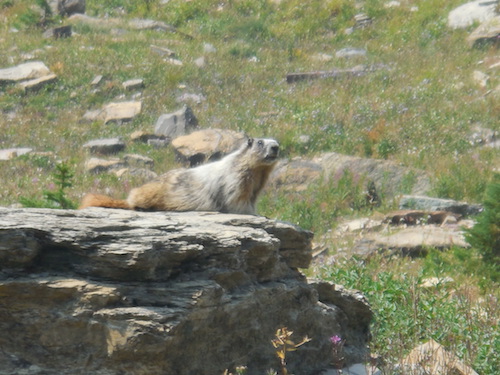 I paid $5 for a shuttle from the station to Sprague Campground where I snagged an early morning campsite along Lake McDonald Lake and the former occupants also gave me their propane, bear spray and extra food. Score! Friends had warned me to carry bear spray, especially as I planned to hike alone and most of us hiking did just that, the red bottles bobbing on our belts. As I was setting up my tent, I heard bird sounds that seemed unusual and looked over to see a pair of pileated woodpeckers about 10 feet away. They weren't making their signature loud hammering into a tree, but their size and red heads were unmistakable. I felt they were good omens, welcoming me to the great outdoors.
I paid $5 for a shuttle from the station to Sprague Campground where I snagged an early morning campsite along Lake McDonald Lake and the former occupants also gave me their propane, bear spray and extra food. Score! Friends had warned me to carry bear spray, especially as I planned to hike alone and most of us hiking did just that, the red bottles bobbing on our belts. As I was setting up my tent, I heard bird sounds that seemed unusual and looked over to see a pair of pileated woodpeckers about 10 feet away. They weren't making their signature loud hammering into a tree, but their size and red heads were unmistakable. I felt they were good omens, welcoming me to the great outdoors.
I was able to access the free Going-to-the-Sun road shuttles provided by the Park Service for almost anywhere I wanted to go and the first hike was a 4 miler along Avalanche Creek to Avalanche Lake. I passed along a raised boardwalk through a forest of ancient western hemlocks and red cedars. The humidity in this valley allows the cedars to grow to heights of 100 feet, and diameters of 4 to 7 feet. Some of the trees in this area are more than 500 years old and it was humbling to be in their midst. Along the hike I also saw hundreds of downed trees, the result of recent avalanches thundering down Mt. Cannon.
Hiking the Highline
The next day I was up bright and early to look across Lake McDonald where the high temperatures and smokey haze still obscured what I knew to be magnificent views of the surrounding peaks. I caught the shuttle up to Logan Pass, where the Going-to-the-Sun road reaches its apex over the Continental Divide at 6646 feet, not an amazingly high altitude but enough with the heat to kick my lungs into high gear. The pass is a popular starting point for hiking and backpacking trips. The most popular trail is the Highline Trail which heads north along the west side of the continental divide, through an area known as the Garden Wall, due to the proliferation of wildflowers which grow there during the summer. Some of the wildflowers were still in bloom including pearly everlasting, fireweed and yarrow. At another area where there had been fires, it was very common to see bear grass, named as such by the Lewis and Clark expedition, according to my guide. I heard the story a few times of grizzlies out on the Highline and there was a sighting of a grizzly at Logan Pass the following day, very close to the Visitor's Center. I was told by rangers and others that all the wildlife, especially bears, were suffering due to the lack of berries because of the drought.
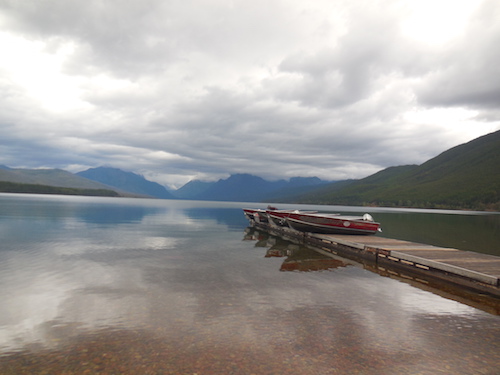 At first the trail follows the road but after a couple of miles it heads into the mountains and all I could hear was my own heart and breath, nearby hikers and much later, the call of an eagle and the high alarm alert of a marmot who stood at attention for at least 5 minutes, making sure that the marmot colony knew the eagle was in the vicinity. I had bought new binocs and enjoyed seeing 3 mountain goats far up on the sides of the mountains, one lying down while the others took their fill of green alpine grasses. By the time I arrived at the Granite Chalet at mile 8 where folks can stay overnight, I was hot and tired. I revived by buying some cold water at the Chalet but nothing could cool me down for the grueling south facing 4 mile downhill to catch the shuttle again at The Loop along the road. I took the shuttle back to my campground, marveling again at Heaven's Peak and the meandering river that helped create the huge valleys in the park. From my perspective, what distinguishes Glacier from the large California national parks like Yosemite, Mt Lassen, Sequoia or King's Canyon are the huge lakes and the species of trees. Going over Tioga Pass in the Sierras, we are greeted by huge granite outcroppings while the landscape here is made up of innumerable forests, some bearing the burned litter of forest fires from the 1930's caused by lightning, which was the case of the 1936 Heaven's Peak fire. Since there are no showers in any of the campgrounds, I bathed and cooled in the bliss of Lake McDonald and settled into watching the sunset.
At first the trail follows the road but after a couple of miles it heads into the mountains and all I could hear was my own heart and breath, nearby hikers and much later, the call of an eagle and the high alarm alert of a marmot who stood at attention for at least 5 minutes, making sure that the marmot colony knew the eagle was in the vicinity. I had bought new binocs and enjoyed seeing 3 mountain goats far up on the sides of the mountains, one lying down while the others took their fill of green alpine grasses. By the time I arrived at the Granite Chalet at mile 8 where folks can stay overnight, I was hot and tired. I revived by buying some cold water at the Chalet but nothing could cool me down for the grueling south facing 4 mile downhill to catch the shuttle again at The Loop along the road. I took the shuttle back to my campground, marveling again at Heaven's Peak and the meandering river that helped create the huge valleys in the park. From my perspective, what distinguishes Glacier from the large California national parks like Yosemite, Mt Lassen, Sequoia or King's Canyon are the huge lakes and the species of trees. Going over Tioga Pass in the Sierras, we are greeted by huge granite outcroppings while the landscape here is made up of innumerable forests, some bearing the burned litter of forest fires from the 1930's caused by lightning, which was the case of the 1936 Heaven's Peak fire. Since there are no showers in any of the campgrounds, I bathed and cooled in the bliss of Lake McDonald and settled into watching the sunset.
I rested my weary legs the next day by taking a boat ride on Lake McDonald as well as reading from the spacious deck at Lake McDonald Lodge. When I camp out and save money, I treat myself to some of the best food by going to the lodge restaurants. The glass of pinot grigio and pork chop plate was the best meal of the trip, accompanied by live piano music and the occasional vocal rendition of Americana including Eidelweiss sung by a talented server.
Some (not Many) Glacier
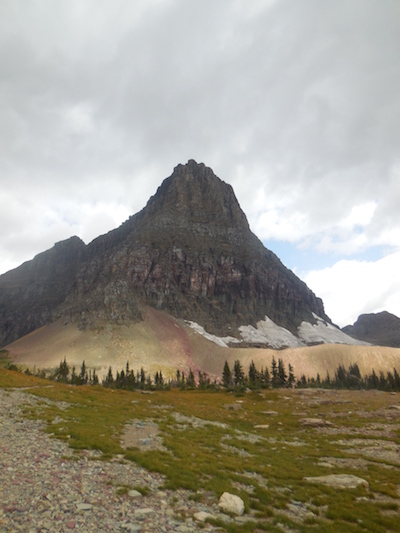 I knew I wanted to see the Many Glacier side of the park but to do so without a car would have taken at least 3 and 1/2 hours to go from west to the east side with two transfers, first at Logan Pass and then at St Mary's on the eastern side of the park. I figured out that I could stay at Apgar Campground and have Glacier Guides pick me up at 6:30am and be at the Swiftcurrent Inn in Many Glacier in 2 hours. It was a great decision since for $85 plus tip I also got the guiding of Hannah for the 10 mile round trip hike to Iceberg Lake. Our small group of one Easterner and her son and two Southeast Indians living in NYC was convivial and Hannah was the kind of young woman I imagined I might have been at her age. At almost 57 years old, I find myself sometimes imaging the what ifs - what if I had grown up outdoors in the West, knowledgable and able to drive and lead hikes, raft rivers and teach skiing in the winter? Actually growing up as I did in West Texas, I could never have led all those activities as a professional guide but I resonated with her adventurous spirit and absolute love of the outdoors. We didn't see any wildlife on the trail but enjoyed seeing numerous wildflowers like yarrow, Indian paintbrush and pearly everlasting besides tasting some thimbleberries, the almost shape and taste of raspberries.
I knew I wanted to see the Many Glacier side of the park but to do so without a car would have taken at least 3 and 1/2 hours to go from west to the east side with two transfers, first at Logan Pass and then at St Mary's on the eastern side of the park. I figured out that I could stay at Apgar Campground and have Glacier Guides pick me up at 6:30am and be at the Swiftcurrent Inn in Many Glacier in 2 hours. It was a great decision since for $85 plus tip I also got the guiding of Hannah for the 10 mile round trip hike to Iceberg Lake. Our small group of one Easterner and her son and two Southeast Indians living in NYC was convivial and Hannah was the kind of young woman I imagined I might have been at her age. At almost 57 years old, I find myself sometimes imaging the what ifs - what if I had grown up outdoors in the West, knowledgable and able to drive and lead hikes, raft rivers and teach skiing in the winter? Actually growing up as I did in West Texas, I could never have led all those activities as a professional guide but I resonated with her adventurous spirit and absolute love of the outdoors. We didn't see any wildlife on the trail but enjoyed seeing numerous wildflowers like yarrow, Indian paintbrush and pearly everlasting besides tasting some thimbleberries, the almost shape and taste of raspberries.
After 3 nights of camping, I was glad I had made a reservation one week prior to stay in a modest but very comfortable historic cabin at Swiftcurrent Inn. When I looked at the next day's weather report and noted a forecast of possible thunderstorms, I added an extra night. Many Glacier is the loveliest part of the park that I experienced. There is a reason that the Northern Pacific Railroad and its owner built the glorious Many Glacier Hotel in 1914-15 at the site of Swiftcurrent Lake, with awe-inspiring peaks in every direction. The name maybe should be changed to Some (Not Many) Glaciers as the size and number of the glaciers is in such retreat. A large windstorm blew into the area that afternoon and I made my way to dinner at the hotel, thumbing a ride for the mile to get there and back as bears are more active at night and I didn't fancy becoming their dinner by startling them in the dark. As I waited for 30 minutes or so to get a table, I enjoyed a strong huckleberry daiquiri. Huckleberries are about the only fruit one can find near the park and they are the summer season standin as I sampled huckleberry lemonade, huckleberry ice cream and even huckleberry salad dressing. I made a mental note to pack more fruit like apples for a return trip. On my way to hitchhike a ride back, I stood on the footbridge over the Swiftcurrent Falls and saw a very fast black bear move across the river and into the brush. I would see one more cub along Going-to-the-Sun road on my crisscross back to the west side, causing what the driver radioed in as a "bear jam."
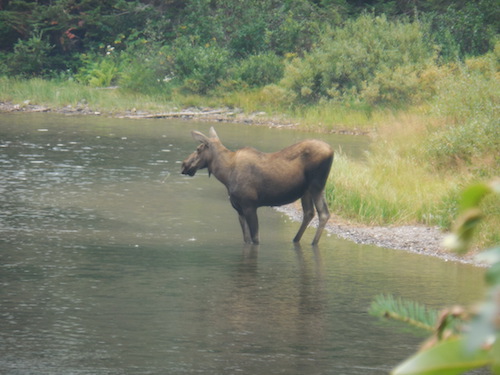 Besides the grizzly, the animal I most wanted to see were moose and Hannah told me to check out Fisherman Cap and Red Rock Lake in the morning. I got a late start but lo and behold, just as I chatting it up with a group of women, I spied a female moose, called a "cow" and her "calf" at Red Rock Lake. They place their snouts way under the water and eat aquatic plants. They are gangly looking creatures with their "bell", a loose bit of skin below their jaws. Moose are the only deer that are capable of feeding underwater. As an adaptation for feeding on plants underwater, the nose is equipped with fatty pads and muscles that close the nostrils when exposed to water pressure, preventing water from entering the nose. I later saw a solitary moose feed underwater for at least 15-20 seconds, seemingly enjoying the food but also the cooling water.
Besides the grizzly, the animal I most wanted to see were moose and Hannah told me to check out Fisherman Cap and Red Rock Lake in the morning. I got a late start but lo and behold, just as I chatting it up with a group of women, I spied a female moose, called a "cow" and her "calf" at Red Rock Lake. They place their snouts way under the water and eat aquatic plants. They are gangly looking creatures with their "bell", a loose bit of skin below their jaws. Moose are the only deer that are capable of feeding underwater. As an adaptation for feeding on plants underwater, the nose is equipped with fatty pads and muscles that close the nostrils when exposed to water pressure, preventing water from entering the nose. I later saw a solitary moose feed underwater for at least 15-20 seconds, seemingly enjoying the food but also the cooling water.
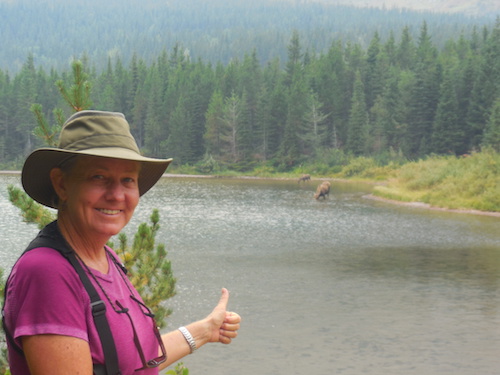 We finally got a good rainfall and the next day and my final one in the park was one of partial rain clouds and excellent visibility. I took the shuttle back to Logan Pass and was able to stow my luggage in the ranger lounge where a fireplace warmed up the staff. I walked out the most popular short hike in the park, Hidden Lake Overview, passing impressive alpine meadows and rock faces along the boardwalk. On the way back, I decided I needed a break from the crowd and made a traverse into an area where only a few hikers were, and I was rewarded by seeing 2 coyote before they disappeared as quickly as they had appeared. I sat down with my back to a log, gazing out over Logan Pass and eastward. I tried to imagine what the park must be like in the silence of winter, covered by feet of snow with the road and access all closed for months at a time and most of the mammals hibernating. It was starting to sprinkle and time to head back to the west end of the park, in time to walk and gaze for another hour at Lake McDonald and contemplate nothing at all.
We finally got a good rainfall and the next day and my final one in the park was one of partial rain clouds and excellent visibility. I took the shuttle back to Logan Pass and was able to stow my luggage in the ranger lounge where a fireplace warmed up the staff. I walked out the most popular short hike in the park, Hidden Lake Overview, passing impressive alpine meadows and rock faces along the boardwalk. On the way back, I decided I needed a break from the crowd and made a traverse into an area where only a few hikers were, and I was rewarded by seeing 2 coyote before they disappeared as quickly as they had appeared. I sat down with my back to a log, gazing out over Logan Pass and eastward. I tried to imagine what the park must be like in the silence of winter, covered by feet of snow with the road and access all closed for months at a time and most of the mammals hibernating. It was starting to sprinkle and time to head back to the west end of the park, in time to walk and gaze for another hour at Lake McDonald and contemplate nothing at all.
Train Trip West Glacier to Seattle
After barely making it onto the train after a quick "All aboard," I was back enjoying the easy sway of the Empire Builder as it headed toward the sunset and Seattle but not before a slow climb up to a higher elevation and a pass through western Montana where there seemed to be at least one foot of snow on the ground. I fell asleep and woke to the news that we had been delayed by 2 1/2 hours in the middle of the night in Spokane! Such luck was mine as I had made my flight reservation a full 4 hours after the scheduled arrival, knowing that the return trip is often delayed. I now had 2 1/2 extra hours to enjoy the splendid scenery as we passed the apple orchards of eastern Washington, then followed the Columbia River for awhile before turning northwest and heading toward Puget Sound. One of the most fascinating parts of the train trip back was the 15 minutes of deep dark while going through the longest tunnel in the United States. The New Cascade tunnel was put in service on January 12, 1929, and is still in operation, connecting Chelan County on its east with Scenic Hot Springs in King County on its west. Because of safety and ventilation issues, this tunnel is a limiting factor on how many trains the railroad can operate over this route from Seattle to Spokane with the current limit at 28 trains per day. The Scenic Hot Springs mentioned on the western side of the tunnel seem worthy of further exploration as they are on private land (surrounded by public land) but can be accessed by making a minimal donation and a reservation here. I would save that trip for another day.
|
|



 Karen's Perspective on Traveling Alone
Karen's Perspective on Traveling Alone


 Karen's Perspective on Traveling Alone
Karen's Perspective on Traveling Alone